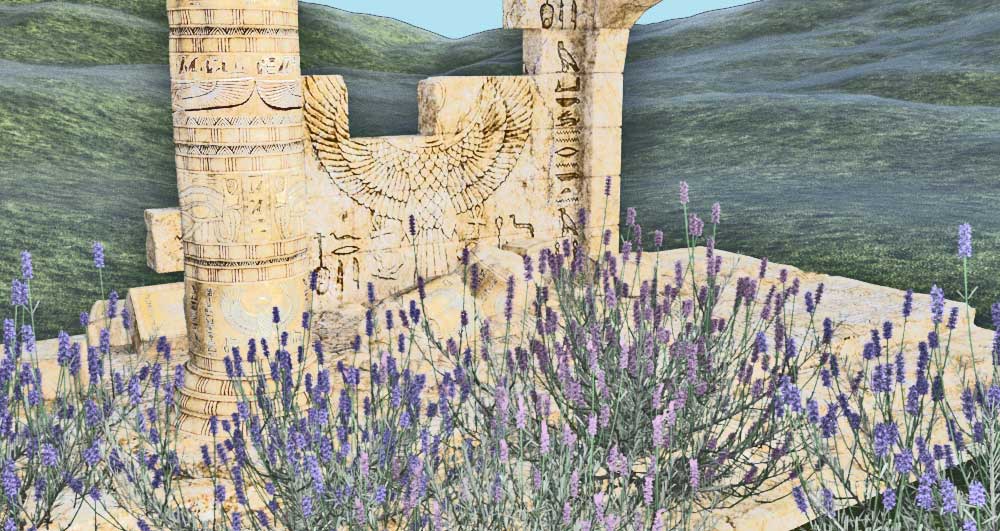Lavender in Ancient Egypt

The ancient egyptians loved their lavender!
The aroma of lavender is a blend of fresh, floral, and herbal notes. The presence of these scents in the herb has it being used for the creation of perfumes and other beauty products. It can also be found in household items like pillows, linen sprays, and air fresheners. These are just a few examples that have led us to believe that lavender is only useful as an aromatic plant with medicinal properties.
However, this isn’t the case in ancient Egypt where its uses go beyond what we know today. Let’s take a look at some of the ways they used it back then!
Cultural Uses of Lavender in Ancient Egypt
Beyond its aromatic value, lavender was used for a variety of cultural purposes. These include using the herb for decorations, votive offerings, and even for religious rituals. Ancient Egyptians believed that the presence of lavender in a room resulted in peace, comfort, and the ability to induce sleep. They often used it to scent their home's and temples. Its green, purple, and white flowers made it ideal for bouquets, garlands, and headdresses.
Other cultures also employed these uses, but none quite as much as ancient Egyptians did.
Ritual Purposes
Lavender held significance in many cultures. In the Chinese culture, it was used to represent the East and Yin, the feminine energy. The Greeks believed that the herb was used to attract the sun goddess, and in Hinduism, it was believed to be a representation of the god of love, Kamadeva. Lavender also still holds significance in Christianity where it is sometimes used as a substitute for incense in church.
In ancient Egypt, lavender was used in rituals to honor the gods and goddesses, particularly Isis. It was also used to cleanse and purify the body and space. Back then, people also believed that the scent of lavender had the power to drive away evil spirits and bring about positive energy. The herb was also used to make incense for religious ceremonies.
Dried Lavender for Incense
Incense was extremely common in ancient Egypt and it was used for a variety of different purposes. One of the main purposes was for ritual cleansing and purification. People used a number of different herbs for the purpose of incense. and among the herbs that were commonly used were myrrh, frankincense, and lavender.
The lavender was likely grown locally in the Nile Delta, and the myrrh was imported from East Africa and the Arabian Peninsula. These ingredients were used along with other items like charcoal, sandalwood, and storax. These were added to create a scented incense that was used in religious ceremonies.
It was believed that the incense would have helped to purify the air in the temples. It would have also been used for healing purposes, like to help cure headaches and relieve anxiety.
Lavender to Cleanse and Purify
In ancient Egypt, lavender was used to cleanse and purify the air. It was added to bath water and used to scent clothing. Lavender was also used in some recipes as a substitute for soap. It was added to milks and broths in order to remove impurities and toxins from the body. Lavender was also used to clean the skin. It was added to ointments and balms that were applied to the skin to help heal wounds and burns.
Lavender as Medicine
Lavender was used as medicine by the ancient Egyptians. It was used in a variety of different ways as medicine. One of the ways in which it was used as medicine was for curing headaches. People would use it to create a balm that they would put on their temples to cure headaches. It was also used to help cure coughs and colds.
The ancient Egyptians used lavender to create a salve that they would then use to treat wounds and burns. Interestingly, they also used the lavender to help cure snake bites.
Given that the Egyptians had a lot of uses for lavender as medicine, it is no wonder that the herb was so highly valued.
Lavender as a Baking Ingredient
Lavender is used in cooking and baking these days, but it was also used in cooking and baking back in ancient Egypt. Lavender was an ingredient in the making of the popular Egyptian sweet cake known as “Hekat.” Hekat was a cake that was made with wheat flour, honey, and cinnamon. For this reason, it was actually a healthier cake than many that we eat today.
The dried flower buds were likely used in the Egyptian version of shortbread cookies. This was done to add a sweet flavor and aroma to the cookies. It is likely that these cookies were used during religious ceremonies or for special occasions. The cookies would have been made with all-purpose flour, butter, and sprinkling of lavender. The cookies were likely made and baked over a low flame.
Conclusion
The uses of lavender in ancient Egypt extend beyond its aromatic and medicinal value. This herb was used for a wide variety of purposes, including decorations, votive offerings, incense, and even for religious rituals. Beyond its medicinal uses, lavender was applied for its ability to cleanse and purify. It was also used to create a soothing atmosphere.
The cultural and ritualistic purposes of lavender in ancient Egypt show that this herb was much more than a simple scent.